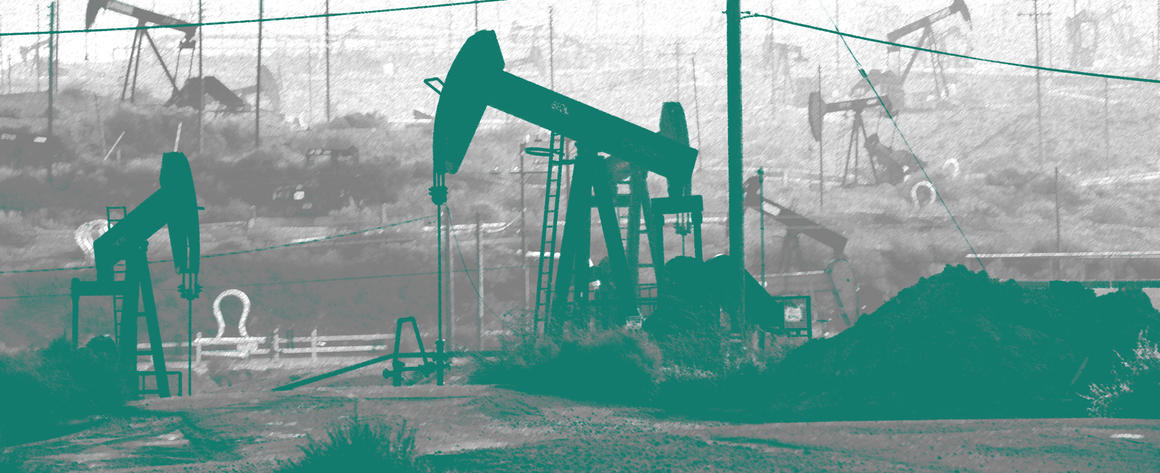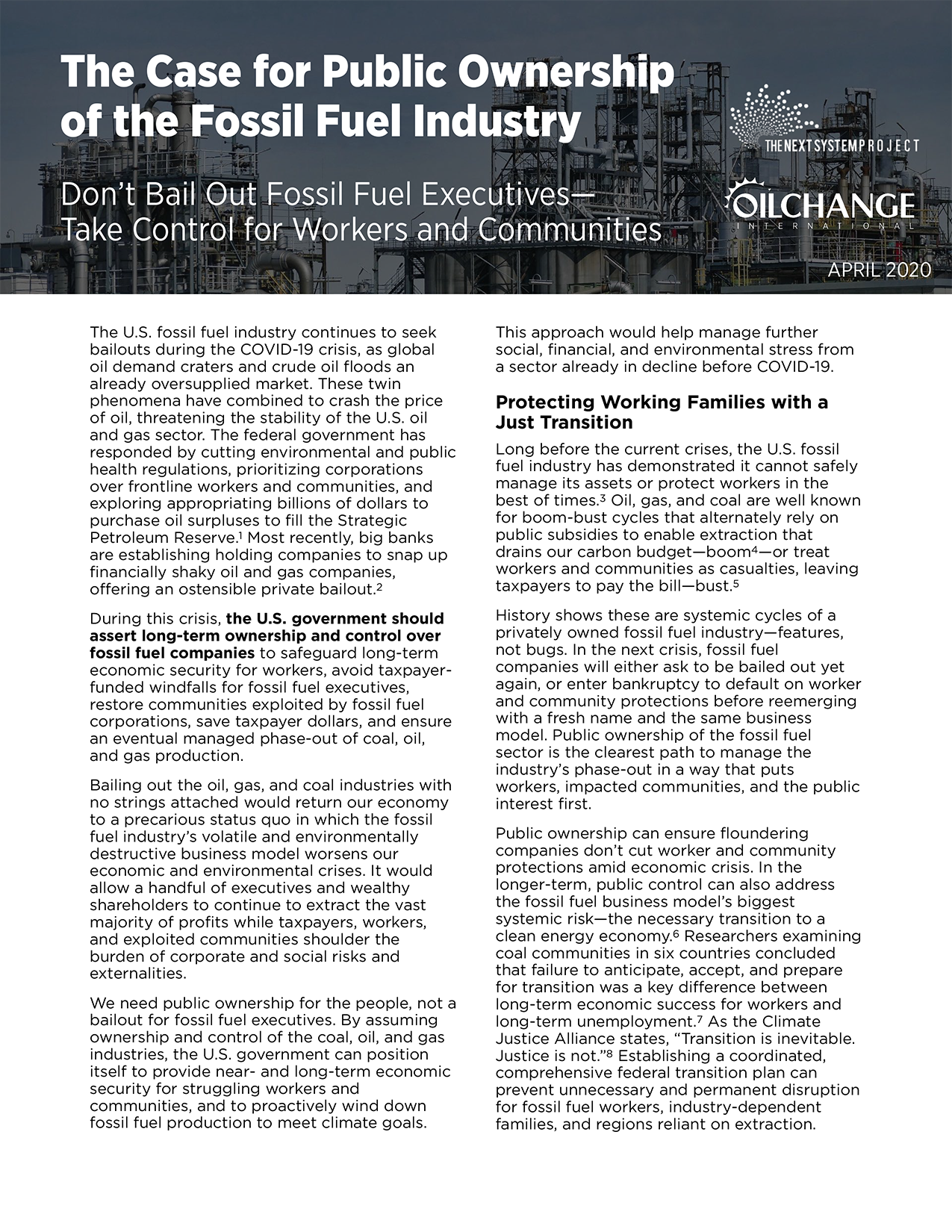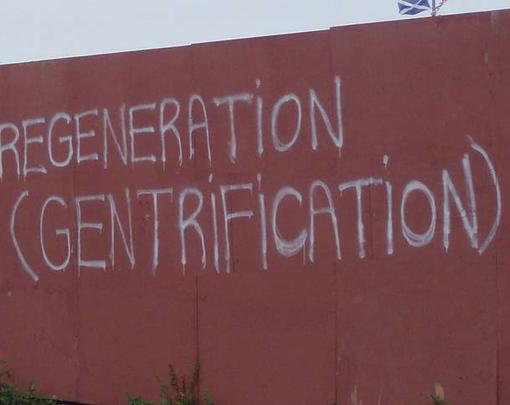This report is being released in conjunction with Oil Change International.
The U.S. fossil fuel industry continues to seek bailouts during the COVID-19 crisis, as global oil demand craters and crude oil floods an already oversupplied market. These twin phenomena have combined to crash the price of oil, threatening the stability of the U.S. oil and gas sector. The federal government has responded by cutting environmental and public health regulations, prioritizing corporations over frontline workers and communities, and exploring appropriating billions of dollars to purchase oil surpluses to fill the Strategic Petroleum Reserve.1 Most recently, big banks are establishing holding companies to snap up financially shaky oil and gas companies, offering an ostensible private bailout.2
During this crisis, the U.S. government should assert long-term ownership and control over fossil fuel companies to safeguard long-term economic security for workers, avoid taxpayer-funded windfalls for fossil fuel executives, restore communities exploited by fossil fuel corporations, save taxpayer dollars, and ensure an eventual managed phase-out of coal, oil, and gas production.
Bailing out the oil, gas, and coal industries with no strings attached would return our economy to a precarious status quo in which the fossil fuel industry’s volatile and environmentally destructive business model worsens our economic and environmental crises. It would allow a handful of executives and wealthy shareholders to continue to extract the vast majority of profits while taxpayers, workers, and exploited communities shoulder the burden of corporate and social risks and externalities.
We need public ownership for the people, not a bailout for fossil fuel executives. By assuming ownership and control of the coal, oil, and gas industries, the U.S. government can position itself to provide near- and long-term economic security for struggling workers and communities, and to proactively wind down fossil fuel production to meet climate goals. This approach would help manage further social, financial, and environmental stress from a sector already in decline before COVID-19.
Protecting Working Families With a Just Transition
Long before the current crises, the U.S. fossil fuel industry has demonstrated it cannot safely manage its assets or protect workers in the best of times.3 Oil, gas, and coal are well known for boom-bust cycles that alternately rely on public subsidies to enable extraction that drains our carbon budget—boom4 —or treat workers and communities as casualties, leaving taxpayers to pay the bill—bust.5
History shows these are systemic cycles of a privately owned fossil fuel industry—features, not bugs. In the next crisis, fossil fuel companies will either ask to be bailed out yet again, or enter bankruptcy to default on worker and community protections before reemerging with a fresh name and the same business model. Public ownership of the fossil fuel sector is the clearest path to manage the industry’s phase-out in a way that puts workers, impacted communities, and the public interest first.
Public ownership can ensure floundering companies don’t cut worker and community protections amid economic crisis. In the longer-term, public control can also address the fossil fuel business model’s biggest systemic risk—the necessary transition to a clean energy economy.6 Researchers examining coal communities in six countries concluded that failure to anticipate, accept, and prepare for transition was a key difference between long-term economic success for workers and long-term unemployment.7 As the Climate Justice Alliance states, “Transition is inevitable. Justice is not.”8 Establishing a coordinated, comprehensive federal transition plan can prevent unnecessary and permanent disruption for fossil fuel workers, industry-dependent families, and regions reliant on extraction.
The implications for management of the transition—and by extension the fate of workers and communities—are immense. Public ownership would shift control of U.S. fossil fuel reserves from profit-driven, myopic shareholders to a government acting in the public interest. Rather than lobbyists running the show, the government could mandate oversight of a managed phase-out of fossil fuel production via an independent Federal Just Transition Agency.
Federal Support and Community Control for a Just Transition
The concept of a just transition originates from the labor movement and has been further developed by frontline communities; these communities have experienced systemic socioeconomic disparities, environmental racism, and other forms of injustice, and include low-income communities, Indigenous peoples, and communities of color.9 A just transition charts a pathway to phase out polluting industries by winding down physical points of extraction and production, reducing economic dependence on fossil fuels, and eliminating the political power of Big Oil, Gas, and Coal in a planned and equitable way focused on workers and communities. The transition must not only wind down polluting industries, but also “build the new” by creating healthy and just economies.10
A Federal Just Transition Agency would receive and manage fossil fuel assets with the express goal of a phase-out grounded in just transition principles, and coordinate and finance investment in public and community infrastructure for a new, resilient economy.11 Processes like those in the Climate Equity Act of 2019 should be used to ensure accountability to frontline communities and labor unions through policy development and implementation.12 The transition should also build on such grassroots efforts as Gulf South for a Green New Deal’s Policy Platform and the Climate Justice Alliance’s Just Transition Principles.13
A Federal Just Transition Agency would be grounded in input from workers, labor unions, impacted communities, environmental justice advocates, Indigenous peoples, state and local governments, climate scientists, and other key stakeholders. Organized with federal standards and financial support, paired with communities’ control of planning, the agency would be guided by worker interests, would model transparency, and would deploy funding to impacted communities and workers.14
Federal Standards and Support: A federally managed transition agency can implement coherent, worker-friendly phase-out plans and mandates to reduce pollution and kickstart community renewal. This means policies like guaranteeing fossil fuel workers at least five years’ wage replacement or wage insurance, secure pensions and health benefits, full-benefit voluntary retirement for those eligible, extensive job training, and relocation support.15 Concrete policy to increase the power of workers and labor unions must accompany all efforts to phase out fossil fuel extraction.
Communities bearing the scars of pollution and health impacts but reliant on the fossil fuel industry for jobs and tax revenue must also receive federal support to transition local economies, including by reclaiming and remediating extraction sites.16 Every step of the transition must comply with federal environmental monitoring and reporting standards and mandate high-quality working conditions for all involved. Revenues generated by public control of the oil, gas, and coal sector should be used for transition support, though additional federal support will also be needed.
Local Control and Planning: A federal just transition system would allow for coordinated regional transition planning and comprehensive climate policy to prioritize local needs. Through local and regional authorities, community stakeholders can guide the transition to minimize impacts on workers and communities, while swiftly ending fossil fuel expansion and winding down existing fossil fuel production in line with 1.5ºC climate limits.17
These authorities can help diversify economies, quickly deploy resources, and invest in decommissioning infrastructure, wells, and mines, while foregrounding environmental justice principles18 by reclaiming and restoring air, soil, and water.19 Putting communities in charge can help the transition to a new economy avoid perpetuating harm through new modes of extraction, and instead transfer opportunity and ownership to those on the frontlines and fence lines. The transition should also be used to build the power of unions and workers’ rights in all parts of the new economy, ensuring that new jobs are union jobs.20 This critical work is already underway; regional planning for a new economy has already begun in a number of regions, including such historical extractions centers as the Gulf South,21 Appalachia,22 and Alaska.23
Principles for Fossil Fuel Public Ownership
• Investment in People, Not Polluters: Workers and communities must be put first in all decision-making scenarios, with a just and equitable transition the top priority.
• Commitment to Climate Success: All operations must align with global 1.5ºC scenarios, featuring an immediate end to fossil fuel expansion and a managed phase-out of production.
• Communities in Control: Democratic control must be prioritized in the transition to a regenerative economy, using federal support and standards with community control.
• Out with the Old: The transition to public ownership must immediately remove management responsible for the crisis and eliminate opportunity for political capture.
• Accountability for Polluters: Fossil fuel executives must be held accountable for their actions, including climate disinformation, human rights abuses, and climate damages.
Paths to Public Ownership
Public ownership of the fossil fuel industry means acquiring long-term authority via majority or full control of companies and assets in the U.S. oil, gas, and coal sectors. Once in control of a company, decision-making powers would be transferred to the Federal Just Transition Agency.
Acquiring oil, gas, and coal companies with an explicit plan for a just transition and managed phase-out of production would put an end to the annual use of taxpayer dollars to subsidize the reckless industry driving the climate crisis—conservatively, U.S. federal aid to oil, gas, and coal production measures $15 billion per year.24 It would also save hundreds of billions of dollars in averted climate impacts and future bailouts. There are a number of ways for the federal government to acquire public ownership of the fossil fuel industry; a successful effort would almost certainly require a combination of strategies.
Condition Bailouts and Stimulus Funds on Equity: Any publicly financed relief to fossil fuel companies during the COVID-19 crisis and future crises could be conditioned on government acquisition of a controlling equity stake with full voting rights, with the additional condition that the government would exercise those voting rights to retool company components aligned with a green economy, remediate contamination, and wind down extraction operations with fully funded transition support for workers. Such conditional bailouts would likely require a new law to deploy the U.S. Treasury or the Federal Reserve’s emergency lending powers to acquire the assets. While this is a clear path to nationalization, it is an elective process that companies can avoid by not accepting a bailout.
In the wake of the 2008 recession, Congress authorized bailouts on acquisition of various securities, but generally failed to acquire or exercise significant decision-making power.25 The government acquired a 36% ownership stake in Citigroup, but contractually limited its voting rights following pushback from White House Chief of Staff Rahm Emanuel and Treasury Secretary Timothy Geithner.26 The most recent COVID-19 stimulus bill—the CARES Act of 2020—allows for the acquisition of equity stakes but does not condition aid upon it, and expressly prohibits the government from exercising voting rights.27
Place Bankrupt Companies in Government Receivership: In a particularly timely path to public ownership, Congress could modify bankruptcy law to require any fossil fuel company filing for bankruptcy to be placed into governmental receivership. Coal companies are well known for exploiting bankruptcy processes to shed commitments to workers,28 and the U.S. oil and gas industry could soon replicate this shameful pattern. U.S. shale company Whiting Petroleum filed for Chapter 11 bankruptcy this month,29 while Norwegian energy consultancy Rystad Energy projects that there could be hundreds of Chapter 11 filings by upstream oil and gas companies in the next two years.30 If the cascade of oil and gas reorganizations in coming months is handled incorrectly, there could be a mass transfer of risks to the public, while the fossil fuel industry and its executives could emerge with little penalty.
In late 2008, the Bush administration provided a bridge loan to General Motors to keep the company afloat, with congressional approval. Subsequently, the Obama administration guided the company through bankruptcy by providing $30.1 billion in-possession financing, taking a 60.8% ownership stake after General Motors emerged from bankruptcy. The federal government then used this ownership stake to mandate reorganization and force a leadership change.31 New law could also expand such action to fossil fuel companies with debt ratios contributing to systemic financial risk or heavily indebted companies with large self-bonding obligations, even if these companies had not yet entered bankruptcy.32
Purchase Equity Stakes through Existing Authority: The Federal Reserve has the power to buy and sell financial assets to regulate systemic risk,33 which means it can acquire majority stock ownership with voting rights over publicly listed fossil fuel companies using existing authority.34 As the COVID-19 crisis and climate scenarios have made clear, fossil fuel companies pose a systemic financial risk to the stock market and economy. While straightforward for publicly traded companies, this power could not be used to acquire privately held companies.35
The Federal Reserve’s authority to acquire equity—particularly to exercise voting rights and actively manage assets—has been a contested topic for scholars and past Federal Reserve chairs,36 but such activity is relatively common for other central banks. In late 2019, the Swiss National Bank held nearly 20% of its portfolio in equities.37 New law clarifying the Federal Reserve’s authority to acquire equity and actively manage companies under ownership would make this path to public ownership even clearer.
End Private Ownership of Fossil Fuel Companies: In one of the simplest paths to public ownership, Congress could ban private ownership of fossil fuel companies. New law could direct the Treasury Department or the Federal Reserve to acquire full stakes in publicly traded fossil fuel companies and accompanying assets, and to negotiate transfer agreements with privately held companies.
There is a long history of crisis action to acquire public ownership of various industries for the public good. During World War I, Woodrow Wilson used his powers under the Army Appropriations Act of 1916 to nationalize the railroads because they were vital to the war effort but being poorly coordinated by private industry.38 More recently, the Aviation and Transportation Security Act of 2001 required all airport security screening to be carried out by federal employees, effectively banning private contractors and transferring operations to the new Transportation Security Administration.39
Acquire Privately Held Companies and Assets through Eminent Domain: Using eminent domain, the federal government can acquire land and infrastructure associated with fossil fuel production to bring oil, gas, and coal into public ownership. Eminent domain allows the federal government—as well as state and local governments—to acquire assets in exchange for “just compensation,” and could also be utilized to acquire both public and privately held assets and companies.40 Typically acquisition is proposed through negotiation, but in the event that an asset holder does not agree to sell, the government can seize the assets, with compensation determined by courts or arbitration.
During the New Deal era, the federal government frequently used its powers of eminent domain to create national parks and to build hydroelectric dams. To create the Tennessee Valley Authority, the federal government used eminent domain to acquire the private Tennessee Electric Power Company’s land, dams, and transmission systems, then expanded the assets and established the federally owned power company that persists to this day. State and local governments also utilize eminent domain on a daily basis for development and public benefit.41 Though one of the simpler paths to acquire ownership of privately held companies, this strategy would likely face significant legal and political hurdles.
Valuation for Public Takeover—What is ‘Just Compensation’?
Traditional oil, gas, and coal company valuation is founded on the assumption that these businesses will continue to drill, mine, expand operations, and invest in large infrastructure projects for many decades to come. This methodology largely neglects externalities of the fossil fuel industry’s pollution, the cleanup of which is often left to local communities and governments. It also fails to account for the fact that nearly all fossil fuel-based operations will be made rapidly obsolete if the world seeks to achieve global climate goals.
The inclusion of factors such as asset stranding under a 1.5ºC scenario, an appropriately high social cost of carbon, or federal market regulation to properly price companies in the context of systemic climate risk could significantly lower the valuation of oil, gas, and coal industries from current calculations.
How to Get Started
These paths to public ownership each have advantages and disadvantages; they are context-dependent, and it is likely that some combination of these strategies and more will be needed to actualize a transition to public ownership, a robust just transition program for workers and communities, and a phase-out of fossil fuel production. In the meantime, there are concrete steps that members of Congress and the next president can take to prepare to establish public ownership of the fossil fuel industry.
Legislative Action
- Establish a Just Transition Agency: Congress could create a Just Transition Agency to become a vehicle for public ownership of fossil fuel assets. The agency could distribute funds for a just transition and establish management structures ready to acquire assets and property.
- Condition COVID-19 Stimulus Bailouts: Congress can condition any COVID-19 bailout funds available to the fossil fuel industry on ownership stakes in order to manage a just transition to protect workers, communities, and the climate, and ban the use of stimulus funds for fossil fuel expansion.
- Modify Bankruptcy Law: Congress could modify bankruptcy law so that any company with primary operations in oil, gas, and coal production will be automatically transferred into governmental receivership upon filing for bankruptcy, including Chapter 11 reorganization.
- Clarify Federal Reserve Powers: Congress could require the Federal Reserve to consider climate change as a key systemic financial risk, and explicitly empower the central bank to acquire equity stakes, exercise voting rights, and actively manage business assets.42
- Stop the Private Bank Fossil Fuel Bailout: Congress could close loopholes from the Financial Services Modernization Act of 1999 to prevent private bank ownership of commodities and thwart a rumored private bank buyout of floundering fossil fuel companies.43
Executive Action
- Call for Public Ownership of Fossil Fuels: The president can use the power of the office to call for public ownership of the fossil fuel industry as a way to immediately secure the livelihoods of workers and communities in crisis, and enable the U.S. and the world to meet climate goals.
- Appoint Key Advocates: The president can make political appointments in key agencies—including the Federal Reserve Chairman, Treasury Secretary, and Interior Secretary—dedicated to securing public ownership of the fossil fuel industry for a just transition.
- Establish a Just Transition Task Force: The president can establish a Just Transition Task Force with the explicit goal of laying the groundwork for a Federal Just Transition Agency, easing the transfer of fossil fuel assets into public ownership, and pushing Congress to fund such an agency.
Conclusion
Fossil fuel workers and impacted communities need immediate support during the unprecedented COVID-19 health and economic crises, and longer-term support to achieve a just transition to a clean energy economy. The privately owned fossil fuel sector has repeatedly demonstrated its inability to address community, worker, or environmental concerns. While urgent health and economic relief have rightly taken center stage, the climate crisis continues apace and a phase-out of fossil fuel production remains an imperative to achieve global climate goals and avoid catastrophic impacts. In terms of global equity, the United States is uniquely positioned to move away from extraction, with little economic dependence on fossil fuel production and high capacity to fund a just transition.44
Public ownership of the fossil fuel industry can halt its volatile boom-bust cycles, provide short- and long-term security for workers and communities, and implement a managed phase-out of oil, gas, and coal extraction to keep global warming under 1.5ºC. Acting in the public interest, a Federal Just Transition Agency could guide this process with input from workers, labor unions, affected communities, environmental justice advocates, Indigenous peoples, state and local governments, climate scientists, and other key stakeholders. This discussion paper begins to explore paths to public ownership of the fossil fuel industry, and various institutional designs that could support a just transition.
We are living in an unprecedented confluence of health, economic, and climate crises. Our communities deserve better than a deadly system designed to funnel profit to a few executives while workers and communities are left behind and the world burns. We deserve systemic solutions that chart a clear path to a regenerative economy that works for all people, especially those most marginalized.
Questions for Discussion
This discussion paper intends to spark conversation by laying out the case for public ownership of the fossil fuel industry, but there are many areas in need of further discussion. Additional consultation is needed with frontline and fence line communities, workers and unions, fossil fuel-dependent stakeholders, legal and policy experts, and many others.
What follows is a survey of outstanding discussion areas raised by this discussion paper; it is by no means complete and should be built upon as the idea of public ownership for a just transition away from oil, gas, and coal is advanced and realized.
- Legal Authority: What are the additional legal paths or barriers to public ownership of the fossil fuel sector? What steps should be taken in acquiring ownership to mitigate legal risk? How does this intersect with liability claims and other legal cases brought against the fossil fuel industry?
- International Context: How does a transition to public ownership in the U.S. affect international production? How does public ownership affect international climate and trade agreements, and carbon leakage and accounting? How do we prevent multinationals from escaping abroad?
- Community Planning: What are robust examples of regional or local planning for a just transition? What participatory and accountability structures can be put in place? How does the just transition planning intersect with existing regional planning processes?
- Worker Rights: How would the transition to public ownership affect existing union contracts? How would new fossil fuel unions intersect with existing federal employee unions? How can a just transition process be used to strengthen worker rights more broadly than fossil fuel unions?
- Associated Industries: What are the knock-on effects for associated industries such as steel, railroads, shipping, aviation, and others? What steps need to be taken to protect workers and communities dependent on these industries? What can be done to proactively minimize fallout?
Download PDF
For more information or with questions, contact Johanna Bozuwa of The Next System Project, jbozuwa@democracycollaborative.org.
- 1Rebecca Elliott, “Texas weighs curtailing oil production for the first time in decades,” The Wall Street Journal, March 2020; “EPA announces steps to protect the availability of gasoline during COVID19 Pandemic,” U.S. Environmental Protection Agency, March 2020; Dana Drugmand, “Trump admin bypasses Congress, offers backup storage to boost troubled oil industry,” DeSmogBlog, April 2020.
- 2David French, Imani Moise, “U.S. banks prepare to seize energy assets as shale boom goes bust,” Reuters, April 2020.
- 3Matt Phillips, Clifford Krauss, “American oil drillers were hanging on by a thread. Then came the virus.” The New York Times, March 2020.
- 4“The production gap 2019 report,” Stockholm Environment Institute, International Institute for Sustainable Development, Overseas Development Institute, Centre for International Climate and Environmental Research, Climate Analytics, United Nations Environment Programme, November 2019.
- 5David Roberts, “Coal left Appalachia devastated. Now it’s doing the same to Wyoming.” Vox, July 2019.
- 6Kelly Trout, Lorne Stockman, “Drilling towards disaster: why U.S. oil & gas expansion is incompatible with climate limits,” Oil Change International, January 2019.
- 7Ben Caldecott, Oliver Sartor, Thomas Spencer, “Lessons from previous ‘Coal Transitions’ high-level summary for decision-makers,” Institute for Sustainable Development and International Relations, Climate Strategies, June 2017.
- 8“Just transition principles,” Climate Justice Alliance, June 2018.
- 9“’Just transition’—just what is it?” Labor Network for Sustainability, Strategic Practice: Grassroots Policy Practice, August 2016.
- 10“Just transition principles,” Climate Justice Alliance, June 2018.
- 11The Reconstruction Finance Corporation serves as a helpful point of reference; it was a cornerstone of the original New Deal and a public corporation run by the federal government to support and expedite a public works program; see “Reconstruction Finance Corporation (1932),” The Living New Deal, 2019. For a National Investment Authority with similar tenets, see Saule Omarova, “Why we need a National Investment Authority,” Cornell University, April 2020. The Federal Just Transition Agency could work in partnership with or operate a Green Investment Bank; see Thomas Marois, Ali Riza Güngen, “A U.S. green investment bank for all,” The Next System Project, September 2019.
- 12Kamala Harris, Alexandria Ocasio-Cortez, “Background: Climate Equity Act,” July 2019.
- 13Colette Pichon Battle et al., “Gulf South for a Green New Deal Policy Platform,” Gulf South for a Green New Deal, November 2019; “Just transition principles,” Climate Justice Alliance, June 2018.
- 14A state-based Just Transition program proposal is outlined in the Colorado Green Growth Proposal; see Robert Pollin et al., “A green growth program for Colorado,” Political Economy Research Institute, April 2019.
- 15For more, see Bernie Sanders, Jeff Merkley, Edward Markey, “The Clean Energy Just Transition Act,” December 2015. Under certain historical conditions, workers have supported the elimination of their own jobs; see Brian Callici, Mark Paul, “A history of worker displacement,” Data for Progress, December 2019.
- 16The Tonawanda coal plant closure is a helpful example of integrating transition planning with the economic reorganization required for a phase-out of energy infrastructure. New York’s state government provided a loan to support workers, and allocated funding for public services like schools as the economy reoriented; see Elizabeth McGowan, “Rising from the ashes, a Buffalo suburb ends its dependence on coal,” Grist, July 2017; Rebecca Newberry, “Lessons for when the power plant in your town closes,” IEEFA, June 2016.
- 17Trout, Stockman, “Drilling towards disaster: Why U.S. oil & gas expansion is incompatible with climate limits,” Oil Change International, January 2019.
- 18See “Principles of environmental justice,” People of Color Environmental Leadership Summit, October 1991; “Jemez principles for democratic organizing,” Southwest Network for Environmental and Economic Justice, December 1996; among others.
- 19 Though not without its own challenges, the Base Realignment and Closure process used to decommission U.S. military bases is an instructive example of a federal agency employing local decision-making bodies that include community members—called Local Redevelopment Authorities—to plan and implement redevelopment once the base is closed; see “Base Closure and Realignment (BRAC): background and issues for Congress,” Congressional Research Service, April 2019.
- 20“Guidelines for a just transition toward environmentally sustainable economies and societies for all,” International Labour Organization, 2015.
- 21Pichon Battle et al., “Gulf South for a Green New Deal policy platform,” Gulf South for a Green New Deal, 2019.
- 22“New power platform,” Kentuckians for the Commonwealth, August 2019.
- 23Tripp Crouse, Danny Preston, “Just Transition Summit hopes to share ideas about moving away from single resource economies,” KNBA, December 2019.
- 24Janet Redman, “Dirty energy dominance: dependent on denial—How the U.S. fossil fuel industry depends on subsidies and climate denial,” Oil Change International, October 2017.
- 25Gary Corner, “The Troubled Asset Relief Program—five years later,” Federal Reserve Bank of St. Louis, October 2013; Steven Davidoff, “Uncomfortable embrace: federal corporate ownership in the midst of the financial crisis,” Minnesota Law Review, May 2011.
- 26Eric Dash, “US agrees to raise its stake in Citigroup,” The New York Times, February 2009; Ron Suskind, Confidence men: Wall Street, Washington, and the education of a president, June 2012.
- 27U.S. Congress, “Coronavirus Aid, Relief, and Economic Security (CARES) Act,” S. 3548, 116th Congress, 2nd Session, March 2020; Justin Sink, “Kudlow floats U.S. government equity stakes in companies helped,” Bloomberg, March 2020.
- 28Joshua Macey, Jackson Salovaara, “Bankruptcy as bailout: coal insolvency and the erosion of federal law,” Stanford Law Review, April 2019.
- 29Joe Rennison, Derek Browerr, James Fonanella-Khan, “Shale group Whiting files for Chapter 11,” Financial Times, April 2020.
- 30“Heavily indebted U.S. upstream industry on track for record number of Chapter 11 filings in 2020,” Rystad Energy, April 3, 2020.
- 31Conor Clarke, “Now that the government owns General Motors,” The Atlantic, June 2009; CNN Wire Staff, “Obama: GM’s stock sale shows ‘tough decisions’ paid off,” CNN Politics, November 19, 2020.
- 32“Now is the time to end self-bonding,” Western Organization of Resource Councils, April 2018.
- 33This power existed before the CARES Act; see Graham Steele, “A regulatory green light: how Dodd-Frank can address Wall Street’s role in the climate crisis,” The Great Democracy Initiative, January 2020.
- 34Carla Skandier, “Quantitative easing for the planet,” The Next System Project, August 2018. In mid-March 2020, U.S.-based fossil fuel production companies on the New York Stock Exchange had a market capitalization of $554 billion; see “Standard & Poor 500,” accessed March 2020; “Oil & gas exploration & production,” New York Times Markets, accessed March 2020.
- 35Majority ownership requires a 51% to 100% voting stake, but full acquisition is most straightforward. During the 2008 recession, the Federal Reserve at one point held 79.9% control of AIG; see “Actions related to AIG,” Federal Reserve of New York, accessed April 2020.
- 36Greg Shill, “Does the Fed have the legal authority to buy equities?” Confessions of a Supply-Side Liberal, March 2015; Alexander Mehra, “Legal authority in unusual and exigent circumstance: the Federal Reserve and the financial crisis,” University of Pennsylvania Journal of Business Law, March 2011.
- 37“Foreign exchange reserve and Swiss franc bond investments,” Swiss National Bank, December 2019.
- 38Thomas Hanna, “A history of nationalization in the United States,” The Next System Project, November 2019.
- 39U.S. Congress, “Aviation and Transportation Security Act of 2001,” S. 1447, 107th Congress, November 2001.
- 40“Eminent domain overview,” FindLaw, July 2019. While privately held oil and gas companies are often relatively small producers, there are important market players that need to be taken into public ownership and wound down—most notably Koch Industries, the second-largest privately held company in the United States, with annual revenues of over $100 billion.
- 41Hanna, “A history of nationalization in the United States,” The Next System Project, November 2019.
- 42Concerns and suggestions for how the Federal Reserve’s management of CARES Act-related funding could be immediately improved were outlined in a letter to Federal Reserve Chair Jerome Powell in March 2020; see “30 Groups Release Letter to Fed Raising Concerns Over Details of BlackRock Deal,” BlackRock’s Big Problem, March 2020.
- 43French, Moise, “U.S. banks prepare to seize energy assets as shale boom goes bust,” Reuters, April 2020. The Obama-era Federal Reserve proposed a rule to close these loopholes and strengthen limits on private bank ownership of commodities, but the rule was not finalized; see Jesse Hamilton, “Fed Seeks Aggressive Limit on Wall Street Commodity Holdings,” September 2016. More recently, legislation has been introduced to prohibit private banks from acquiring more than a 25% stake in businesses; see Jesús García, Rashida Tlaib, “Reps. García, Tlaib Introduce Bill to Protect Consumers from Market Manipulation,” November 2019.
- 44 Greg Muttitt, Sivan Kartha, “Extraction and Equity,” Oil Change International, Stockholm Environment Institute, forthcoming 2020.





